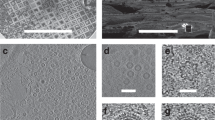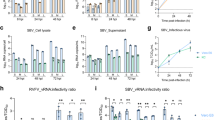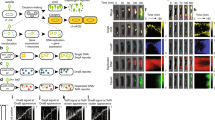Abstract
The study of recombination in prokaryotes has been facilitated by the availability of recombinational mutants and simple genetic elements such as phages and plasmids. These small but defined molecules of DNA have been especially useful for electron microscopic analysis of structural detail of molecules undergoing recombination both in vivo and in vitro1–3. A limitation in the structural analysis of plasmid recombination is the absolute number of recombining molecules which can be identified and analysed amidst a background of nonrecombining molecules3. This limitation would be of even greater consequence in studies of genetic recombination in animal cells. We therefore chose virus-infected animal cells as a model system for the study of the molecular mechanism of genetic recombination in higher organisms. HeLa cells infected with adenovirus serotype 2 (Ad-2) offer several advantages for studying recombination: (1) the virus contains a small and well characterized genome of about 35 kilobases; (2) a large amount of Ad-2 DNA is accumulated during lytic infection and host DNA synthesis is suppressed4; (3) Ad-2 recombines at a very high frequency5,6; and (4) similar to phages, animal viruses and Ad-2 in particular are believed to use many of the host cell's enzymes in necessary metabolic processes, presumably including recombination. In this study we used electron microscopic techniques to visualize the structures of in vivo Ad-2 DNA recombination intermediates. Molecules were observed with structures at putative cross-over points which were consistent with the molecular mechanism of recombination proposed by Holliday7. In addition, we observed Ad-2 DNA molecules engaged in recombination which were simultaneously serving as templates for replication and/or transcription. To the best of our knowledge, this is the first visualization of in vivo recombination intermediates of discrete DNA molecules isolated from eukaryotic cells.
This is a preview of subscription content, access via your institution
Access options
Subscribe to this journal
Receive 51 print issues and online access
$199.00 per year
only $3.90 per issue
Buy this article
- Purchase on Springer Link
- Instant access to full article PDF
Prices may be subject to local taxes which are calculated during checkout
Similar content being viewed by others
References
Broker, T. J. molec. Biol. 81, 1–16 (1973).
Valenzula, M. & Inman, R. Proc. natn. Acad. Sci. U.S.A. 72, 3024–3028 (1975).
Potter, H. & Dressler, D. Proc. natn. Acad. Sci. U.S.A. 73, 3000–3004 (1976); Cold Spring Harb. Symp. quant. Biol. 43, 969–985 (1978).
Philipson, L. & Lindberg, U. in Comprehensive Virology Vol. 3 (eds Fraenkel-Conrat, H. & Wagner, R. F.) 143–227 (Plenum, New York, 1974).
Grodzicker, T., Williams, J., Sharp, P. & Sambrook, J. Cold Spring Harb. Symp. quant. Biol. 39, 439–446 (1974).
Young, C. H. S. & Silverstein, S. J. Virology 101, 503–515 (1980).
Holliday, R. Genetics 78, 273–287 (1974).
Wilhelm, J., Brison, O., Kedinger, C. & Chambon, P. J. Virol. 19, 61–81 (1976).
Wolgemuth, D. J. & Hsu, M.-T. J. molec. Biol. (submitted).
Davis, R. W., Simon, N. & Davidson, N. Meth. Enzym. 21D, 413–428 (1971).
Winnacker, E. L. Cell 14, 761–773 (1978).
Meselson, M. S. & Radding, C. M. Proc. natn. Acad. Sci. U.S.A. 72, 358–361 (1975).
Benbow, R. M. & Krauss, M. R. Cell 12, 191–204 (1977).
Author information
Authors and Affiliations
Rights and permissions
About this article
Cite this article
Wolgemuth, D., Hsu, MT. Visualization of genetic recombination intermediates of human adenovirus type 2 DNA from infected HeLa cells. Nature 287, 168–171 (1980). https://doi.org/10.1038/287168a0
Received:
Accepted:
Issue Date:
DOI: https://doi.org/10.1038/287168a0
This article is cited by
-
Resolution of synthetic att-site Holliday structures by the integrase protein of bacteriophage λ
Nature (1984)
-
Recombination of parent and daughter strand DNA after UV-irradiation in mammalian cells
Nature (1983)
-
Recombination intermediates
Nature (1981)
-
recA-independent general genetic recombination of plasmids
Nature (1981)
-
Does mitochondrial DNA length influence the frequency of spontaneous petite mutants in yeasts?
Current Genetics (1981)
Comments
By submitting a comment you agree to abide by our Terms and Community Guidelines. If you find something abusive or that does not comply with our terms or guidelines please flag it as inappropriate.



